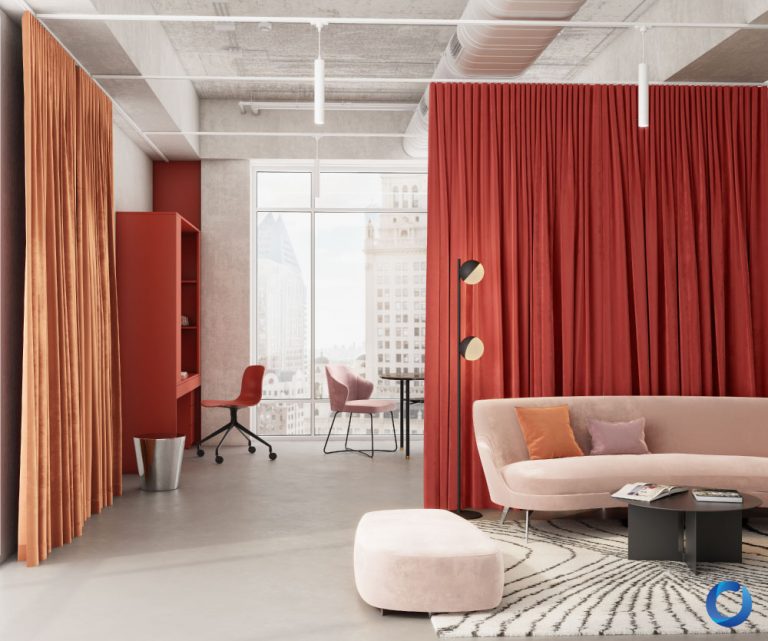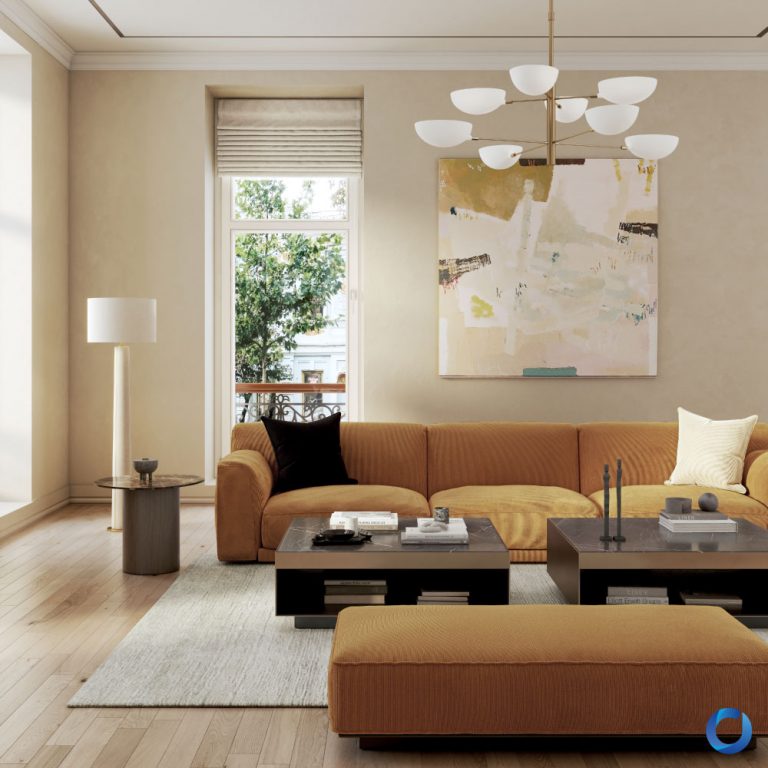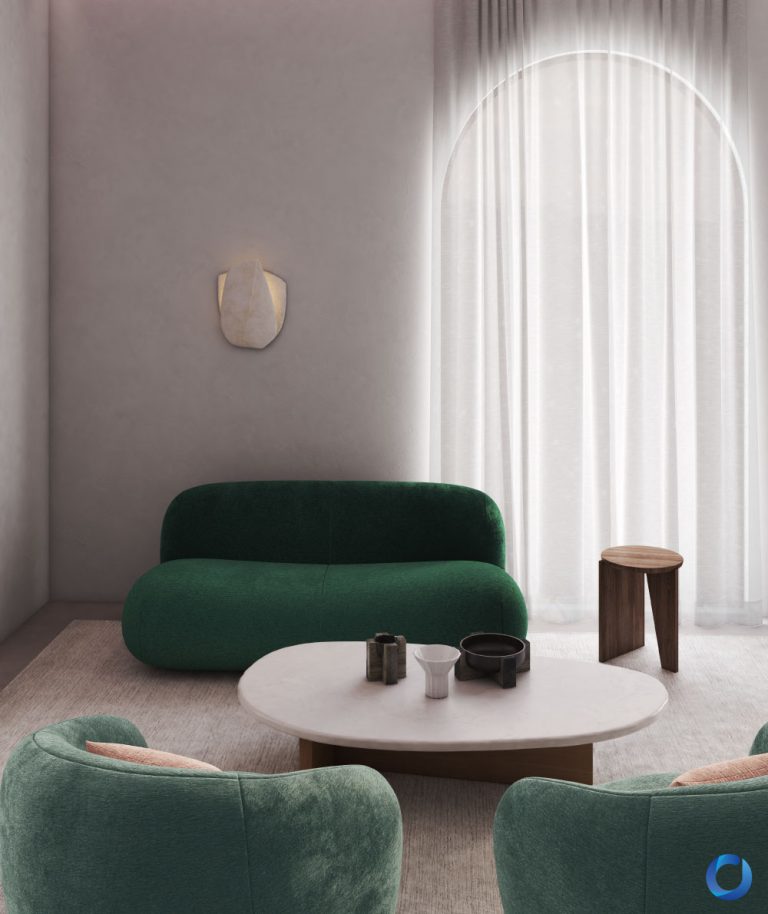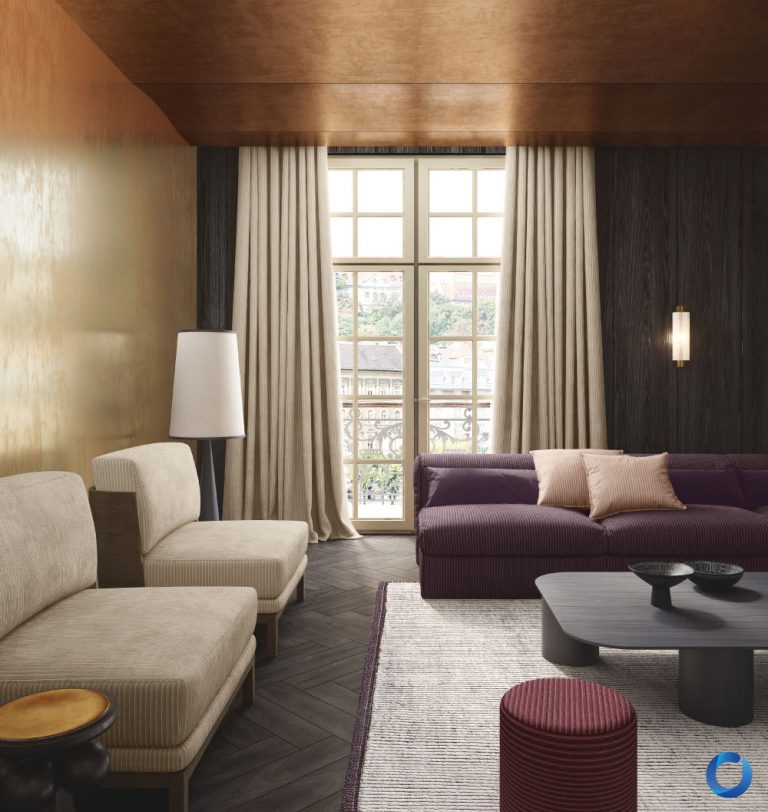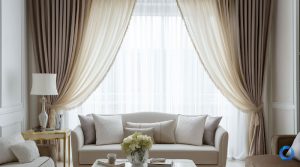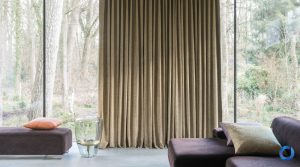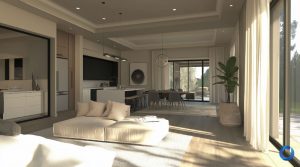
Much like choosing a sofa or a rug, the right window treatment also has the ability to pull a room together but simply hanging a pair of curtains will not make a space look complete. The trick to upgrade your window treatments? Layers.
Beyond just choosing the color, material and length, introducing layered curtains into a space is a great way to make it feel cozier and more luxurious. The art of layering is all about using different curtain styles to enhance its functionality and add visual interest. By combining various textures, your curtain scheme can be a strong design element that makes your decor look more cohesive.
This particular style of decor has been popular in Europe since the medieval times, in which drapes and lace were hung in the homes of aristocrats and royals. The best example of layered curtains being used in European interiors are in Victorian homes where they often paired sheer lace with heavy, ornate drapes made from silk, velvet and Damask. The sheer layer allowed diffused light to enter, while the heavier layer provided privacy and insulation.
Besides the aesthetic benefits, there are also many practical benefits to layered curtains such as light control, airflow and even sound dampening, that you will seldom achieve with single-layer curtains. The key factor is to choose the right type of fabric to fulfil your room’s needs. From blackout curtains and sheers to pattern combinations, we will look into the art of layering curtains, how to select different fabrics, popular pairings and tips for achieving the perfect layered curtain look.
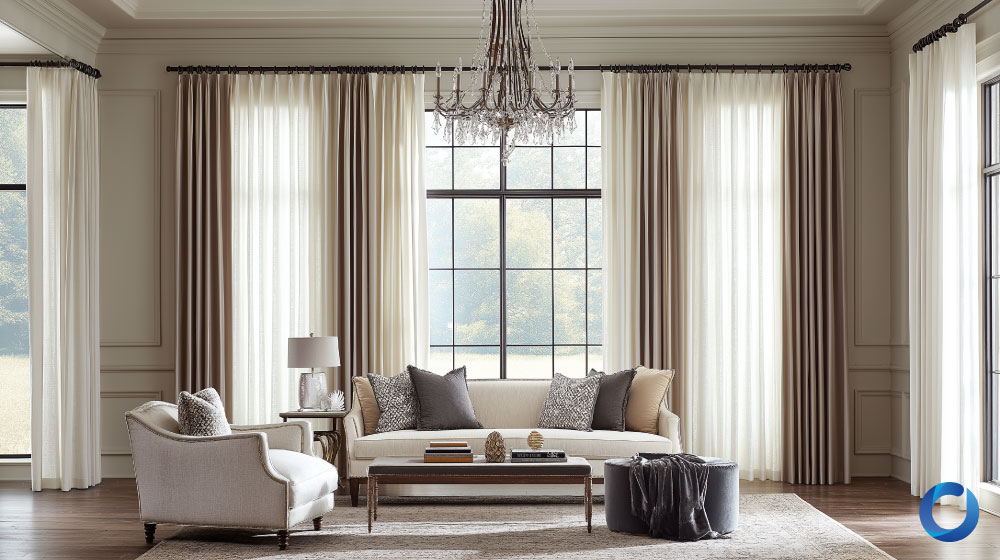
Key Elements of European Layered Curtain Design
A layered curtain scheme consists of a base and secondary curtain but the way to select the combinations and the design is guided by these four factors below.
Fabric combination
Layering curtains is much more than just sliding in curtains onto a rod above the window. To achieve the desired look, it is important to understand the role that each layer will play and consider the space these curtains will adorn.
One of the most popular layering combinations is sheers with opaques. This style is well-loved because it provides the ability to diffuse sunlight or provide complete privacy. This method calls for sheers to be the primary layer and the blackout curtains to be the secondary layer.

Popular fabrics for sheer curtains:
– Voile: A lightweight, plain-woven fabric made from cotton, polyester or a blend of both. It is semi-transparent and soft and flowy by nature.
– Organza: A thin, sheer fabric made from silk or synthetic materials like nylon and polyester. Unlike voile, this fabric has a crisp texture and slightly stiffer drape. This material is more suitable for formal or elegant curtain schemes.
– Chiffon: Similar to organza, chiffon is also made from silk or synthetic fibers but it has a more flowy drape and a textured surface.
– Lace: This is delicate woven fabric with an integrated design. It is typically made from cotton, polyester, or a blend of fibers. It features intricate patterns and designs, providing both privacy and a decorative element.
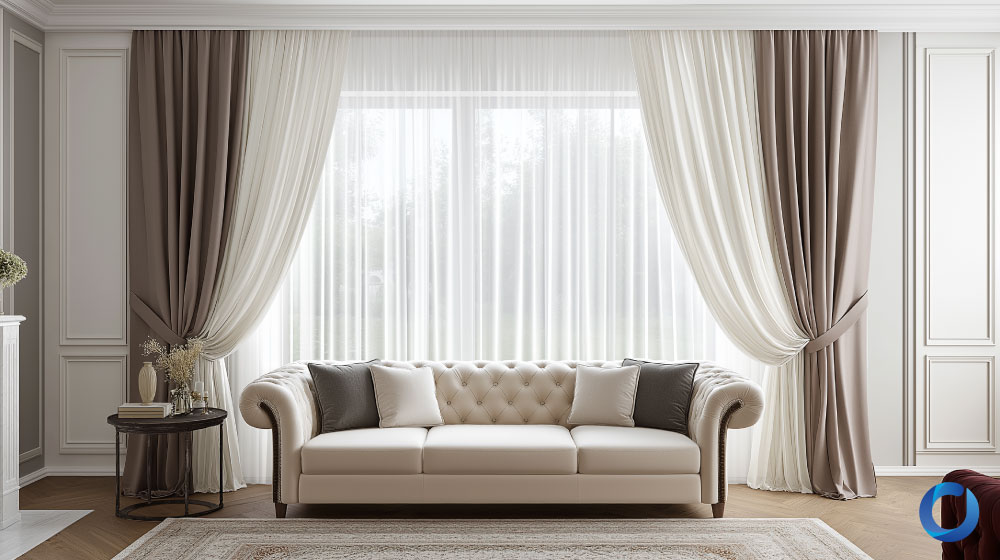
Popular fabrics for opaque curtains:
– Polyester: This is a tightly woven material that has strong light blocking properties. It is durable and easy to care for, which makes a popular choice for many households.
– Velvet: A thick and plush material that can easily block light due to its dense weave. It has a soft, texture feel which gives it a luxurious look.
– Cotton: This is a material made from natural fibre that is often combined with another material or lined to give it a more opaque effect. It is a lightweight, soft and versatile fabric that can be used for curtains in any room.
– Microfiber: A synthetic fabric made from finely woven fibers. It is known for its soft and durable properties. This material is easy to maintain for day-to-day use and is resistant to wrinkles.
European fabric brands such as Fabric Library and Mercis have a wide variety of decorative materials to help you build your layered curtains scheme. High quality and durable, many of their fabrics are fitted with additional features like UV protection and flame retardant such as Fabric Library’s ‘FR-One’ collection.From practical fabrics like polyester blends to luxurious lace, their fabrics are compliant with all of the standard European certifications such as the STANDARD 100 by OEKO-TEX and Organic Content Standard (OCS).
Other popular combinations also include mixing and matching patterns or textures, using an accent color against neutrals or curtains over blind and shades. But regardless of the pairing, ensure your second layer will complement your base curtain.
The color of your curtains can either harmonize with or stand out against the overall aesthetic of your space. To create a seamless look, opt for a curtain color that complements your furniture. If you prefer the curtains to make a statement, choose a hue that contrasts with the walls. Above all, ensure you select a color or pattern that truly resonates with your personal style and improves the overall atmosphere of your room.
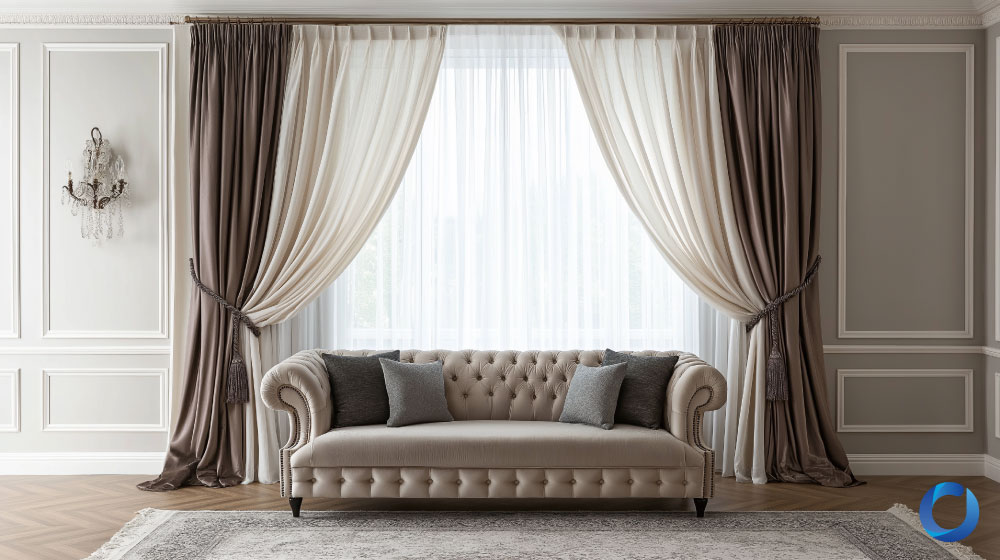
Layering Technique
To mount your curtain design, it is important to ensure the rod or track system can withstand the weight of the fabrics. While you can use a single rod to hang both curtains, the suggested method is to use a double rod or double track system. This allows you to hang each curtain independently.
Some features to look for when shopping for a double rod is a thicker outer rod to support heavier materials and a thinner inner rod for the lightweight layer. For the length, a rule of thumb is to get a rod that is 8 inches wider than the window. This is to ensure the window is fully exposed when you draw the curtains.
The diameter of the rod will be dependent on the type of curtain you have. Some curtains have holes to slide the rod through, while others have clips or rings to hang from the rod. If your curtains have a pocket at the top to thread the rod through, the rod’s thickness should match the pocket’s size.
Ensure your rod also has the appropriate finials at the end. These are not just purely decorative – they also help to prevent the curtain from sliding off.
Proportions and length
In addition to the type of material, it is also important to get the proportions of the curtain right. The height and width of your windows must be measured accurately before you finalise the design. The curtain length can determined based on the desired style but generally there three popular curtain lengths are,
Float: A float is when you want your curtains to “float” right above the ground, less than an inch from the floor.
Kiss: This is when your curtains barely touch or “kiss” the floor. To achieve this effect, ensure you measure the height of the curtain from the rod to the floor accurately.
Puddle: This method is suitable for longer, heavier curtains that can flare out, or “puddle” on the floor. This style is suited for more formal rooms using high-quality fabrics and drapery.
Lining and interlinings
For your secondary layer, you may want to consider getting a lined curtain. Although it is not necessary, a lining is an additional layer of fabric that is sewn onto the back of the curtain to make it thicker and add a few practical benefits.
One of the most important being UV protection against harsh rays. The lining is also necessary in ensuring the curtain can block out the sun completely. This is a key consideration for curtains in south-facing bedrooms. Having a curtain lining will also protect the fabric for longer, especially more delicate fabrics like silk, that can be prone to fading over time.
Leading performance fabric brand, FibreGuard has a wide variety of indoor and outdoor curtains that are designed with a high grade of UV protection that allows the fabrics to retain its color, even after extended exposure to the sun.
But to give your curtains a true custom finish, you can also add an interlining – an additional layer of fabric sewn between the curtain fabric and the curtain lining. Sometimes known as a “bump”, the interlining will make your blackout curtain more effective and improve the soundproofing of your space.
Step-by-step guide to layering curtains
The key to achieving depth and elegance with your layered curtain scheme is to plan every layer by considering how much of your window should be covered and the function that each curtain will play.
1. The primary base layer
For the first layer, it should be laid as close to the wall as possible. This layer is intended to diffuse light and block harsh sunlight, when the outer curtain is drawn open. Thinner materials such as sheers or blinds are perfect for this as they can be positioned close to the window and allow ample space for additional layers.
2. Adding depth with the second layer
The second layer is usually the main decorative or opaque curtains. Full-length curtains or drapes work best because they help to give the illusion of a taller room. To achieve this ensure your curtain rod is placed just a few inches below the ceiling and extended beyond the window’s length to make it look larger than it really is.
Ideally, we would want the curtain on the second layer to be longer than the first layer as this will give your window treatment a more polished and elegant look.
3. Finishing touches with the outside layer
While two layers is sufficient to create a beautiful layered curtain look, you can also add an extra decorative layer such as a valance or pelmet at the top of your curtain scheme. A valance will require another thinner rod to be hung above your curtains, unless you have a rod set that comes with it, also known as the architrave.
Pitfalls to avoid
1. Consider the size of your space and ceiling height to determine the look of your window scheme. Bold patterns and colors work best in larger rooms, while bright colors look better in smaller rooms. Darker and warm colors can help to make a room feel more cozy and comfortable.
2. Try to avoid using more than three layers as too many layers can make a curtain look cluttered. Your chosen fabrics should complement rather than compete with each other.
3. While mixing and matching patterns or textures is encouraged, try to stick to an overall theme that aligns with the overall style of your space. Combining too many different types of decor will make your interior look disjointed.
Conclusion
Don’t limit your window stylings to just a large window. Principles of the layered curtain look can be replicated on any size of window with some adjustments to the scale. Smaller windows, like those in bathrooms or kitchens, can also benefit from this style. A little dressing to the ever popular cafe curtain, a base curtain with a valance or just sheer curtain can be a way to inject some personality into the decor without making a small window look overly fussy or busy.
Ideally, getting custom, bespoke curtains for your layered look will give your window treatments a professional touch. Brands like FibreGuard, Mercis and Fabric Library have extensive customization options that can be tailored fit for your interior’s needs.
References
S.Stacey (2023, March 5) How do you make curtains look expensive? The 6 tips experts swear by – Home & Gardens
M.Sabella (2024, September 24) 9 Types of Curtain Rods and How to Choose the Right Kind – The Spruce
T. Archie (2024, November 28) Successfully Layer Your Curtains With These Simple Tips – House Digest
C.Gao (2024, December 30) 5 Best Fabrics for Sheer Curtains: Everything You Need to Know – Longan Crafts
The Victorian Emporium (2011, August 4) The Evolution of Curtains – The Victorian Emporium
Articles suggestion
Article Suggestion :
- Latest Curtain Design 2024
- 12 Minimalist Premium European Curtain Ideas to Transform Spaces
- Modern Curtain Designs for Contemporary Homes
- Latest European Curtain Trends for Modern Homes
- 2024 Trends in Curtain Designs: What’s New?
- Modern European Curtain Trends for 2025
- Floor-to-Ceiling European Curtains for Luxury Spaces
If you are searching for the perfect curtain to express your personality at home, talk to our sales representatives in here.

